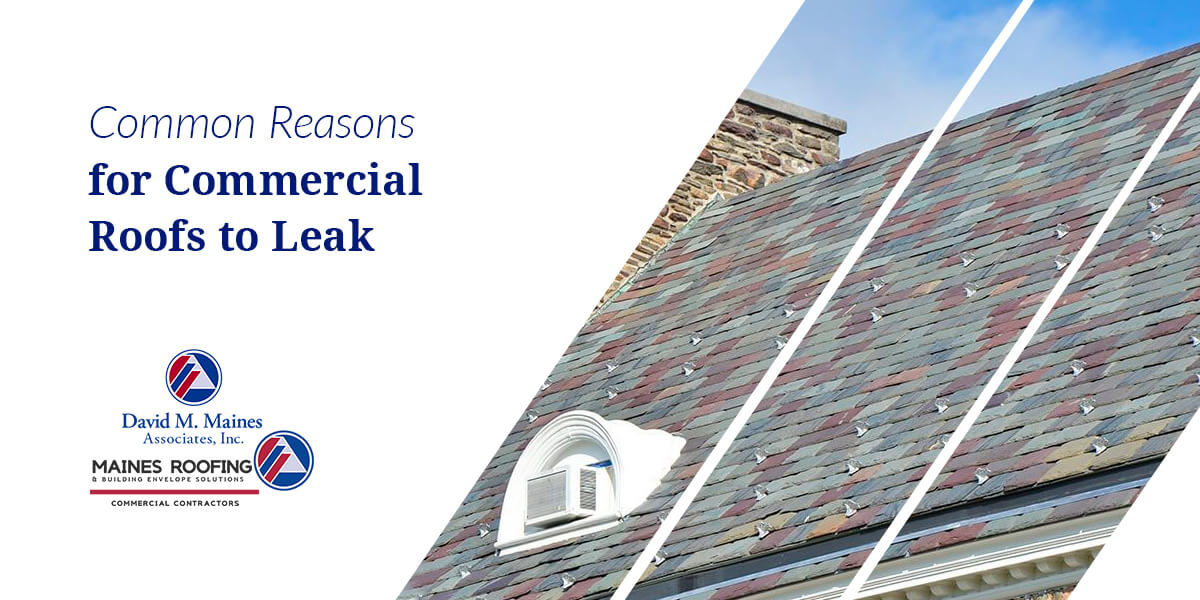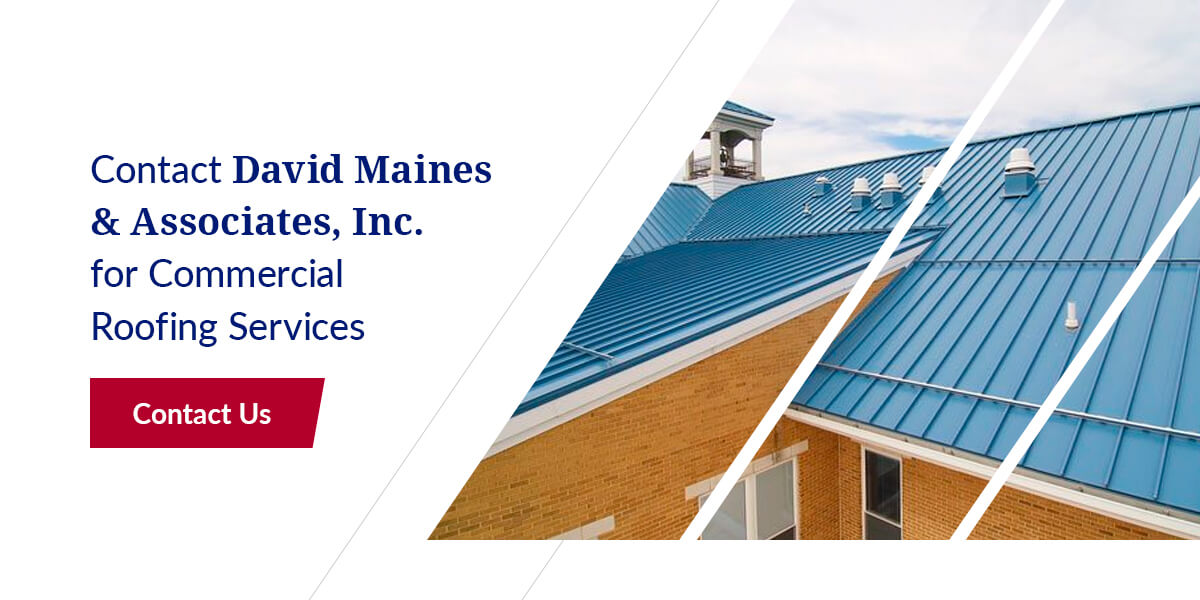Table of Contents
- Why Do Commercial Roofs Leak?
- How to Avoid Commercial Roof Leaks
- How to Handle a Commercial Roof Leak
- Contact David Maines & Associates, Inc. for Commercial Roofing Services
Owning a commercial building provides your business or organization with a comfortable space to achieve success. Upkeeping your building’s features is essential for productivity, and preparing for these features’ maintenance needs can help your building continue operating as usual. A common situation commercial building owners may experience is a roof leak.
Commercial roof leaks can cost you valuable assets that would benefit your business or organization. You can prepare for roof leaks when you know why they happen to commercial buildings and how you can avoid them or prepare for them to occur. Addressing a leaky roof as soon as possible can help protect your commercial building and save you money in the long run.
Why Do Commercial Roofs Leak?
Commercial roofs can leak for several reasons. Understanding why your roof has a leak can help you quickly identify a repair method. Check out some common reasons commercial roofs leak and different clues to spot these causes.
Insufficient or No Drainage
The drainage system can impact your commercial roof’s life span and its ability to avoid leaks. Water can start pooling on your building’s roof if there are insufficient or no drainage systems. The sitting water can seep into gaps or crevices over time and start leaking into your building or apply extra weight to your facility’s structure. Pooling water may also cause moss or plants to sprout on your roof or cause the materials to deteriorate faster.
A drainage system is typically implemented during the roof installation process to prevent water pooling. The main drainage system components your roof should have include drains, downspouts, scuppers and gutters. If these are on your building’s roof, ensure they’re clear of any debris that could block water from running off the roof.
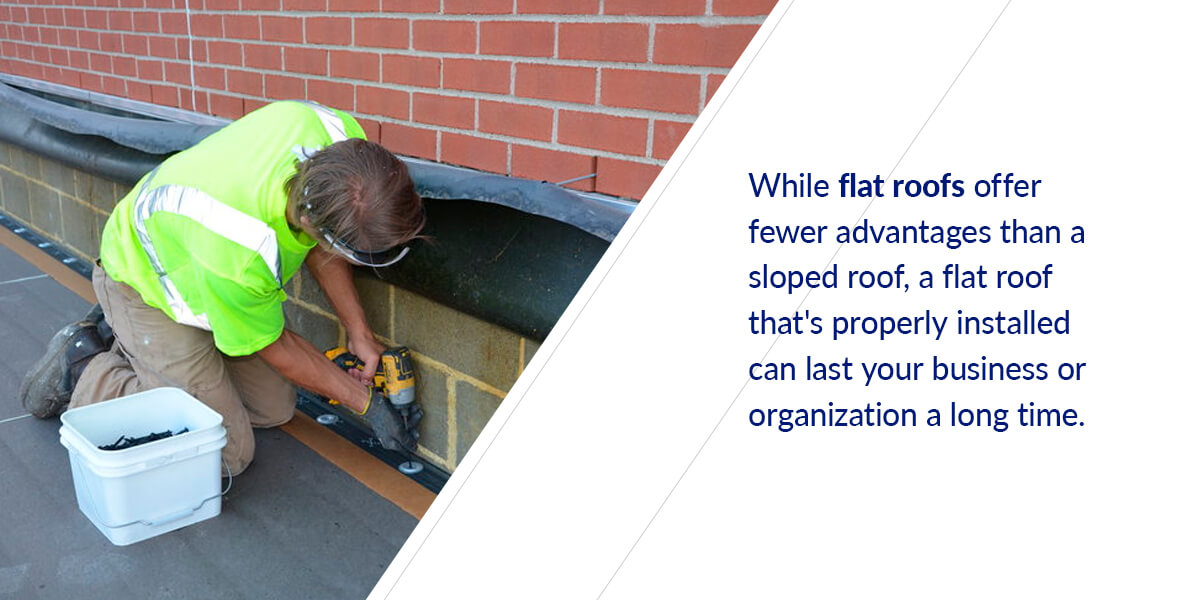
Poor Roof Design or Installation
Commercial buildings typically have flat roofs mainly due to the facility’s wide surface area. While flat roofs offer fewer advantages than a sloped roof, a flat roof that’s properly installed can last your business or organization a long time. When a roofing company poorly designs or installs a commercial roof, the chances of experiencing a leak may increase.
A poorly designed roof may point to limited drainage outlets or a lack of pitch for your commercial building. People may assume that commercial roofs are built flat due to their name, but flat roofs have a slight slope when roofers install them correctly. Selecting a trusted roofing company, like David Maines & Associates, Inc., to install your building’s roof can help protect your structure against leaks and other damages.
Improper Sealing
Your commercial roof will contain various outlets that can be susceptible to water exposure, including:
- Drains
- Vents
- Pipes
- HVAC systems
- Gas lines
- Hot stacks
- Roof lights
These features and any other areas on your roof should be sealed to prevent water from seeping into the roof’s membrane and causing a leak. After a business or organization confirms its building’s outlets are all sealed, it’s crucial to regularly inspect these features to prevent further roof damage.
Poor Maintenance
Like any building aspect, regular maintenance is an essential part of upkeeping the structure and limiting any downtime for your business or organization. Remembering to schedule regular maintenance checks for the roof can help spot problem areas immediately and keep the roof in great condition.
While poor maintenance can be resolved, some factors are out of your control regarding possible damage. While weather factors like strong winds or heavy rain can impact any roof, periodic maintenance can help protect your roof from these damages and other factors.
Flashing Damage
The flashing is one of the two main materials that protect your roof. Flashing consists of the metal pieces that line the perimeter and conjoining areas of the roof. It protects the edges of the roof’s membrane from water and other outdoor elements.
When flashing is exposed to elements like the weather or fluctuating temperatures, it can warp, expand or contract. This damage allows water and excess moisture to flow past the edges of the roof’s membrane and harm the structure of the commercial roof.
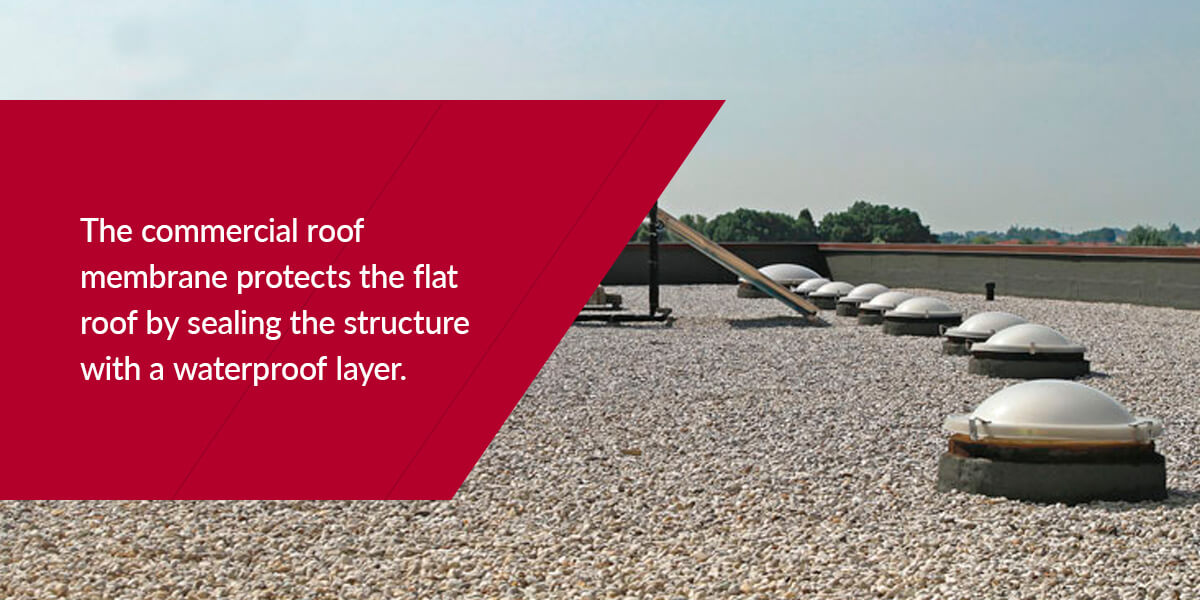
Membrane Damage
Another reason commercial roofs can leak is from roof membrane damage. The commercial roof membrane protects the flat roof by sealing the structure with a waterproof layer. The membrane shields the structure underneath the membrane until factors like the sun, foot traffic, extreme temperatures and mechanical damage impact the membrane. You can spot membrane damage by noticing holes, cracks, blisters or shrinkage in the commercial roof that exposes the insulation.
Your building can experience a leak once the underlying roof insulation is saturated with water. This situation may require a simple repair or necessitate intensive maintenance work to replace large sections of the membrane.
Old Age
Time will take its toll on any structure regardless of its quality or regular upkeep. Your commercial roof’s materials will have an age range of how long they’re meant to last. With regular maintenance and care for your commercial roof, you can help it last as long as possible, but there will still come a time when the elements will impact your roof features and lead to possible leaks and other issues.
When you suspect that your building’s roof is at the end of its life span and it’s experiencing leaks, it’s a good idea to consider a roof replacement.
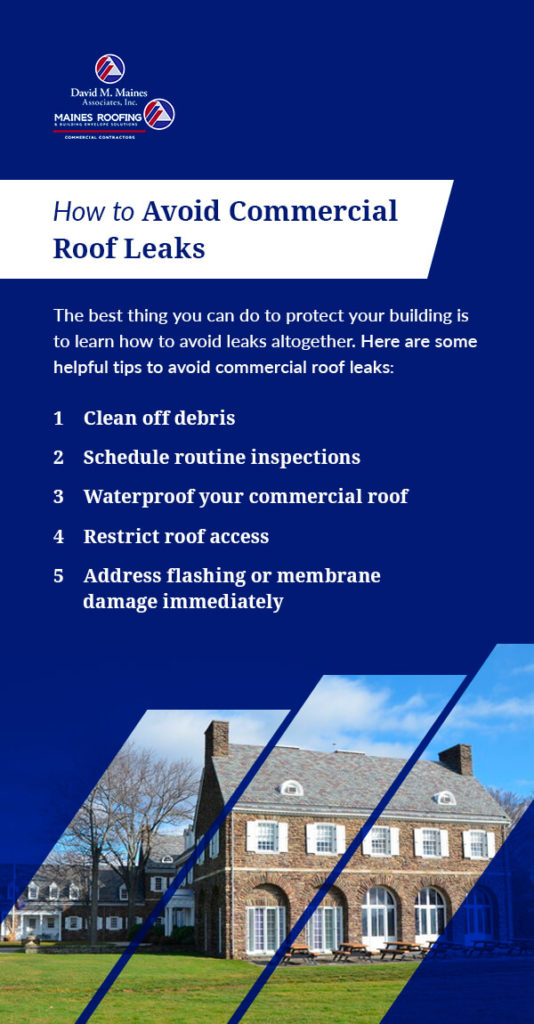
How to Avoid Commercial Roof Leaks
Having a leak in your commercial building’s roof may seem like a small inconvenience at first, but this leak may lead to more damage to your building and use more of your business’s or organization’s valuable time on fixing the problem. The best thing you can do to protect your building is to learn how to avoid leaks altogether.
Here are some helpful tips to avoid commercial roof leaks:
1) Clean off debris
You can protect your building’s roof by making sure it’s clean and free of any debris that would prevent water from draining off the roof. Various objects can block your drainage system. Leaves, branches, dirt and occasional trash can pile up on the building’s flat roof and allow rainwater to pool up. Create a routine of having someone inspect the roof of your building for any dirt or debris that may cause water pooling or damage to the roof materials and lead to a leak.
2) Schedule routine inspections
The best way to ensure your roof stays in shape is to invest in a periodic commercial roof maintenance schedule. When you have a professional regularly inspect your commercial building’s roof, they can point out problem areas before any leaks begin. They’ll look at the roof’s surface, openings and other outlets, perimeter and any areas with sealant. If they spot any cracks or other damages, they’ll have the opportunity to fix them and get your building back in functional condition.
3) Waterproof your commercial roof
Rainwater is fine when you take the right precautions by having quality drainage systems and inspecting your roof regularly. You can up the protection level by waterproofing your commercial roof. David Maines’ commercial waterproofing service can benefit your building by providing moisture prevention, increasing the facility’s value and reducing the number of repairs for leaks and other water damage. This service provides commercial roofs with additional durability and strength against the outdoor elements.
4) Restrict roof access
Significant foot traffic can lead to possible damage over time. Reduce the number of people you provide roof access to and help prevent unwanted damage or leaks in your commercial building. Grant access to individuals who are trained to complete roof repairs or have experience clearing debris off the roof.
5) Address flashing or membrane damage immediately
The flashing and membrane are the two main materials that protect your roof. Looking out for any damage to these components can save your building from leaks. If you notice any cracks, warping or other changes to these materials, contact your roofing professionals for maintenance as soon as possible.
Adopting these routines and upkeep methods for your commercial roof can help protect your building from the dangers associated with roof leaks. If leaks are left unattended, they can start developing into more problematic situations.
Roof Issues Caused by Leaks
1) Wall and ceiling damage
Once the water leaks into the building, it can damage the interior building materials. Paint may start to bubble or flake off because of the water saturation. This type of damage on your walls or ceiling may require a new paint job or drywall replacement. Too much moisture in the drywall can cause ceilings to cave in or sag, which can be hazardous to people in the building — another reason why roof damage should be urgently addressed.
2) Mold and mildew
When you don’t handle leaks right away or miss a leak during your regular inspection, the water that pools in the ceiling or walls can start to grow mold or mildew. Mold and mildew growth happen when water sits in a certain area for a long time, and these issues present themselves in a few ways. You may notice light spots or dark black spots in the affected area. If the mold or mildew is near the building HVAC system, it can continue to spread around the building.
3) Health concerns
A leak can cause health concerns in a couple of ways. Mold and mildew are significant allergens to many individuals, especially for those who struggle with respiratory illnesses. A leak can also be a hazard when water begins to pool on the floor and people in the building don’t notice the puddle. People may slip or fall because of the leak, potentially leading to injuries and future lawsuits.
4) Electrical issues
Your commercial building’s electrical wiring is another crucial feature to consider with roof leaks. While the wires have a casing that can protect them from moisture, some wires may be older or have compromised casings that expose them to water damage. Water can cause wires to short out or potentially emit sparks, leading to a potential fire hazard and posing the risk of injuries.
5) Rotting wood
While the entire framing of your commercial building may use materials other than wood, parts of the roof structure will typically include wood. When the roof starts leaking, the wood features will start absorbing the water. The extra moisture can throw off the material’s equilibrium and cause the wood to expand and contract.
How to Handle a Commercial Roof Leak
Taking precautionary steps against commercial roof leaks can help protect your building for a long time. While these measures help, leaks may still find their way into your commercial building. If you notice a leak in your building, follow a solid action plan. Working on a solution immediately can help minimize damages and keep everyone in your building safe.
The steps you can take to handle a commercial roof leak include:
1) Protect your space and belongings
Water damage can impact valuables in your building like computers, furniture, machines, wall decor, personal belongings and other items. If you notice a leak, remove any items you can that you don’t want the water to hit. If items are too big to move, like desks or other furniture, place a plastic tarp or sheet over them to protect them for the time being. You can also place buckets under the leak to catch the falling water until someone repairs the roof leak.
2) Pinpoint the source
Locating the exact source of the leak can help provide more clarity for the person performing the repairs. Look for issues with the drainage system, roofing materials or other common problems that may have caused the leak. When you find the source, mark the point of entry so your roofing contractor can easily spot the area and start maintenance.
3) Call the professionals for maintenance
After you move items and equipment away from the leak, cover up furniture and other valuable objects with a tarp and pinpoint the source of the leak, call your professional roofing contractor. Many variables go into fixing a leak and ensuring this issue doesn’t continue after maintenance is complete. Hiring a roofing contractor will also save your business the time and energy required for completing roof repairs. Your roofing contractor may suggest a few options for fixing the leak — repairing the specific area, replacing the entire roof or restoring the roof.
Contact David Maines & Associates, Inc. for Commercial Roofing Services
Maintaining the quality of your commercial roof is essential to your building’s structure and your business’s productivity. With less downtime due to roof leaks, your company can spend more time and energy on important work. Instilling your trust in a professional commercial roofing contractor can help you receive fast solutions for multiple roof issues you may face, and David Maines & Associates, Inc. can provide the services you need.
At David Maines, we’re focused on providing your commercial building with the necessary roofing solutions to stop leaks and prevent more from occurring. We use high-quality materials and our expert knowledge to provide our customers with exceptional service. Contact us today to learn more about our commercial roofing services and get started on improving your building’s roof.
Share
